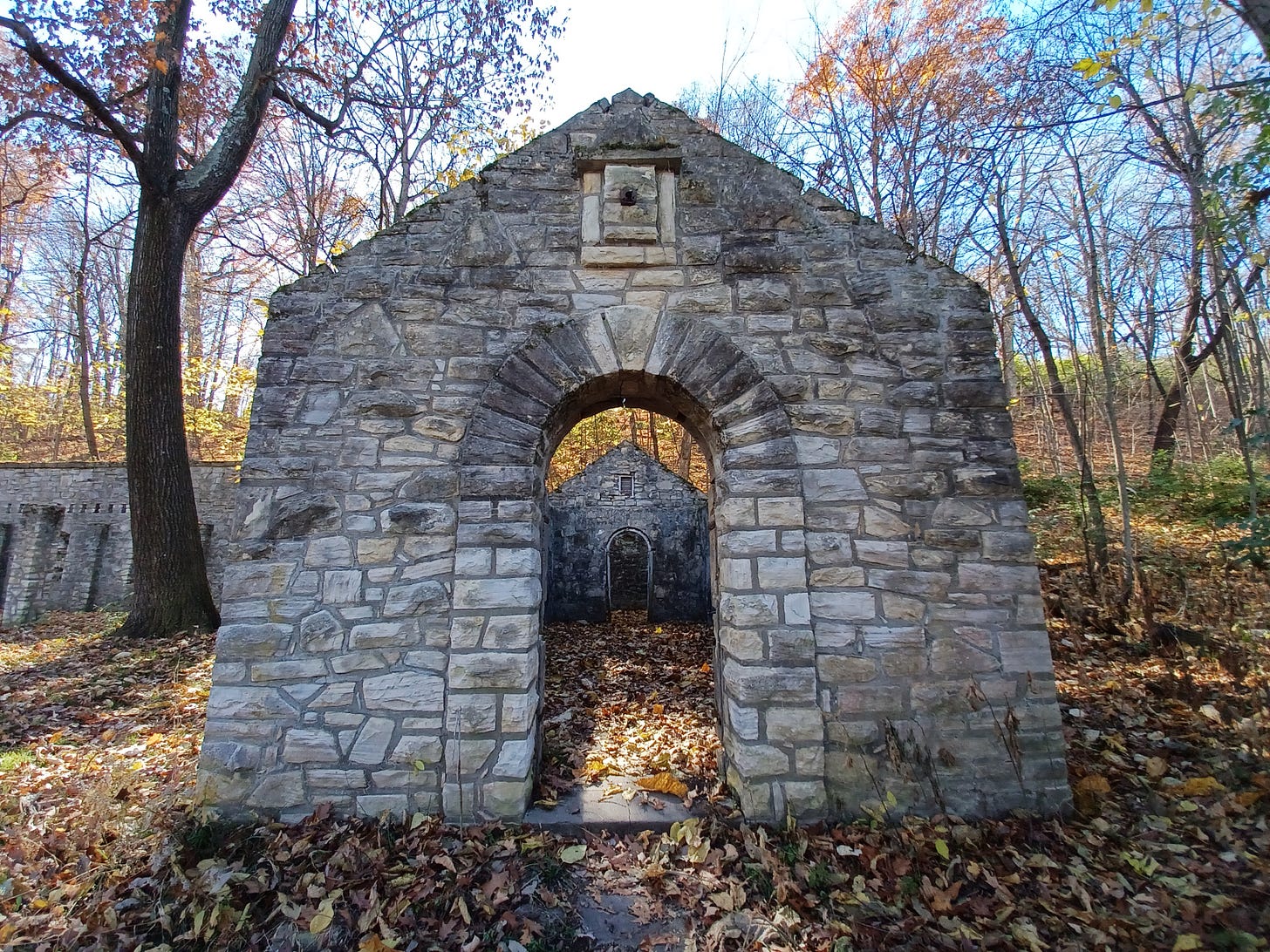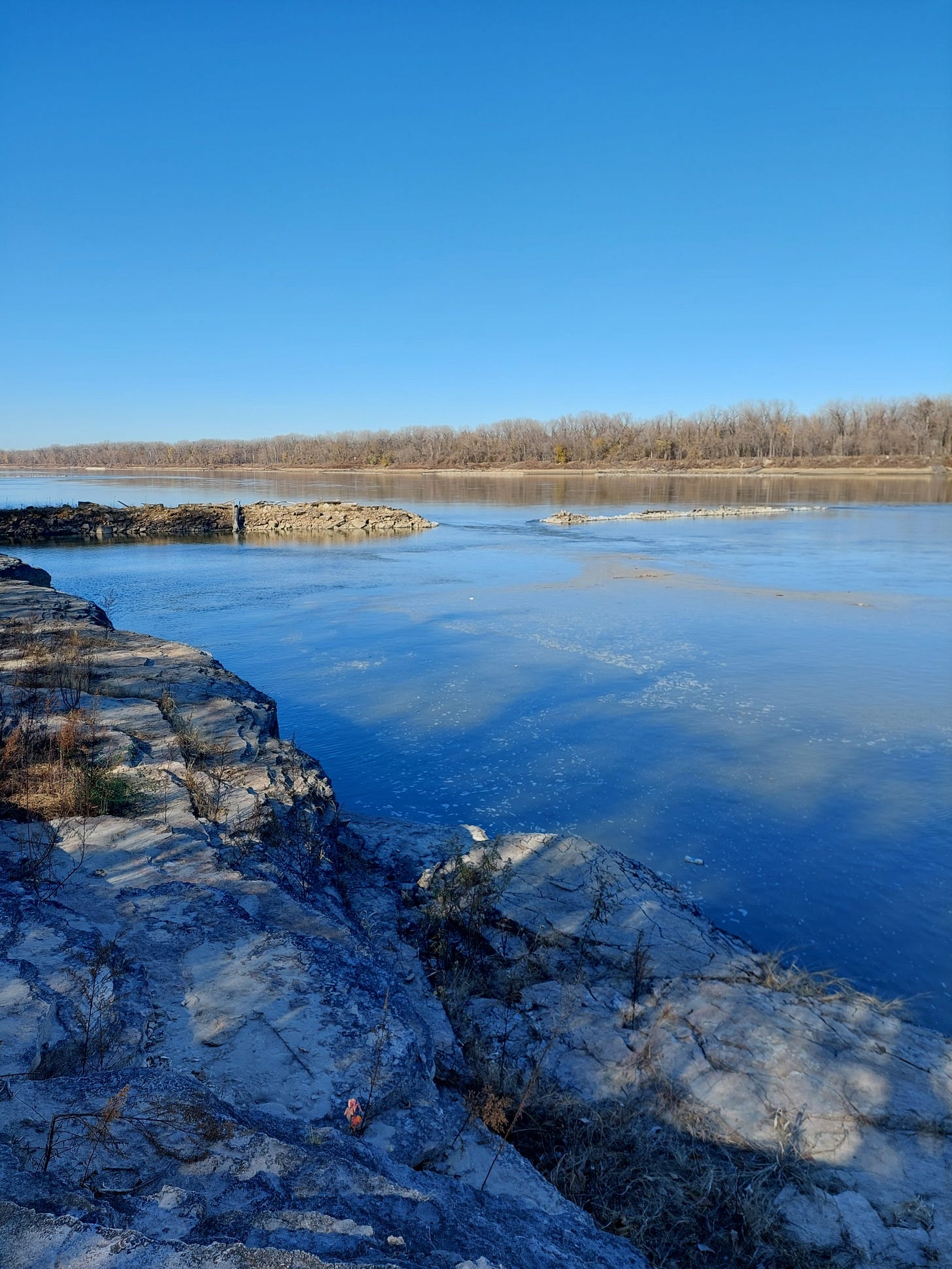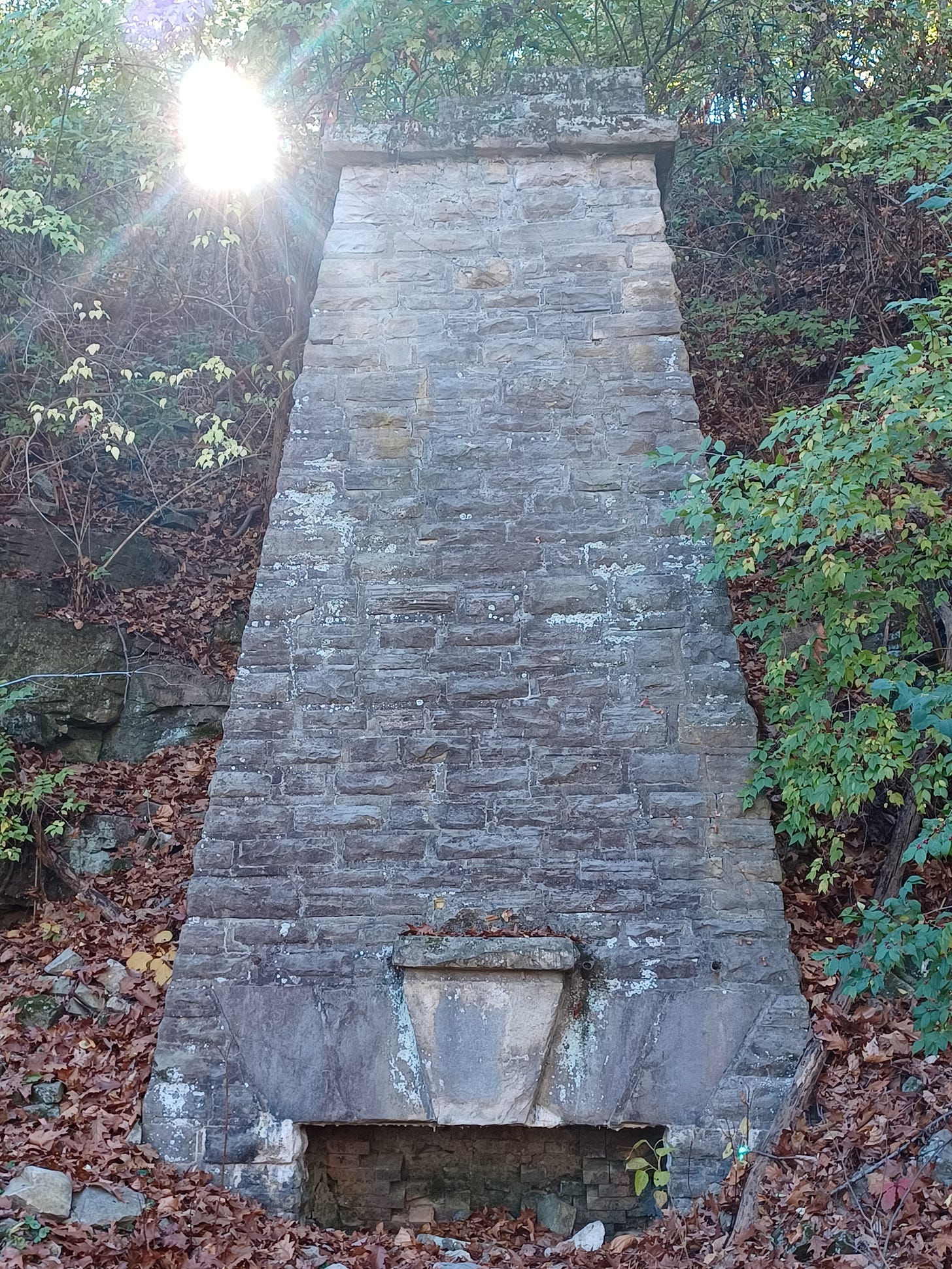In an overgrown field at the edge of a children’s detention center is a five-story stone staircase winding like a maze to the Missouri River. By the river’s edge there is a path, and along the path, lie the ruins.
Some ruins look like small homes. They are made of limestone and coated with moss. The interior walls have scratch marks that look like an animal left them while clawing its way out. There are no roofs or doors, only windows lined with curving iron bars.
You keep walking, looking for an explanation. Placards crop up every now and again to offer a description. But the placards are largely inscrutable: hidden by dirt, faded by time.
On the side of one of them there is graffiti. “Cash is a disease,” it says.
You walk away from the river and deeper into the ruins. Sometimes a recognizable form appears, bringing more questions than answers. You see a kiln and wonder what burned inside. You enter a structure resembling a decapitated cathedral and gaze up at a ceiling of sky. You wander to a long freestanding wall, its bricks missing, its clay torn out like a gutted animal.
You want to sit and contemplate it all. But the lone bench is covered in bristly brush and winding weeds, long ago reclaimed by nature.
There is a signpost gripped by branches. If you move the leaves, you can read the words. They say:
“Lewis and Clark Campsite 14 May 1804. Lewis and Clark Campsite 22 Sept 1806.”
You are standing where Lewis and Clark carried out their expedition to map the territory of the Louisiana Purchase under the orders of Thomas Jefferson. Their journey led to Manifest Destiny, the slaughter of indigenous peoples, and the transformation of a continent into a country. These are the grounds of Fort Belle Fontaine, the first American military post west of the Mississippi River.
Every fall I come here to see what America looked like when it began, and what it will look like when it ends.
I go to Fort Belle Fontaine when fall gives way to winter. It is most scenic and scary then. The rough plants that tear my skin in the spring are dead, and giant golden leaves glimmer on the ground. If you go on a clear day, the Missouri River shines like lapis lazuli, and you can almost forget the stream of radioactive waste nearby.
“At 10 am it seased raining and we collected our party and Set out and proceeded on down to the cantonemt, at Coldwater Creek about 3 miles up the Missouri on it’s Southern banks,” wrote William Clark, a creative speller, in September 1806. “We were honored with a Salute of guns and a harty welcome.”
Fort Belle Fontaine was where Lewis and Clark returned to Missouri after their two-year trek. It is where they camped on their final night, allegedly subsisting on a diet of paw-paws. I hunt for paw-paw fruit in the fall, but I don’t eat any from Fort Belle Fontaine due to nuclear contamination. By the 1960s, Coldwater Creek, a tributary of the Missouri River, had been poisoned by residue from Manhattan Project research, which the US government carried out in St. Louis County. As of 2022, the creek contained lead-210, polonium, and radium. The government refuses to confirm when, or if, they will decontaminate it.
Between the river and the creek are the corpses of soldiers. No one knows exactly where they are. They were buried in the Old Fort Belle Fontaine Cemetery, which was established in 1809 and destroyed by 1904. Most of the identifiable bodies were moved to the military cemetery at nearby Jefferson Barracks. But too much time had passed. The river had eaten away the soil and desecrated the human remains.
Ghosts of the soldiers are said to roam the area, searching for a resting place. Visitors reported seeing them as clouds of smoke, red like blood, hovering by the stairway.
To get into Fort Belle Fontaine, you have to sign in with a security guard. This has nothing to do with the site’s archeological or military status, but with the juvenile detention center on the grounds. The detention center was built in 1913 and still houses children today.
They are worried that the children will get out. I am worried that they won’t.
When I took my own kids to Fort Belle Fontaine, we could see children their ages knocking on the windows of small cabins, calling out, and we felt awful for them. I wondered if they were ever let out to explore, and what they thought of this abandoned land, where the myths of American history are stripped down into something hard and cruel and true.
* * *
One month before, I canoed the Missouri River, traversing part of the route of Lewis and Clark. I had paddled the Mississippi River and smaller rivers south – paddling is an overstatement, like a good Missourian, I floated through the Ozarks with a blissful lack of exertion – but I did not know what to expect from the Missouri.
The Missouri River was rough. It was a seventeen-mile trip in a whipping wind, and though I was not alone, my arms hurt from battling unexpected waves. We paddled under a bridge with a sign saying, “Entering St. Louis County” and I thought how this was the best way to go. Eight people in a canoe, three of them my husband and children, with only yellow-topped trees and bald eagles for company. We were too close to the city for the river to feel remote, but there was a peace to it.
As we paddled, I imagined I was Lewis and Clark, an involuntary reflex. I am of the Oregon Trail Generation programmed in childhood to reenact 19th century westward journeys. Nothing can remove this instinct, embedded in my DNA like fear of dysentery and a penchant for wagon-caulking. History is made of pixels that form horrific new shapes as you get older.
Lewis and Clark are inescapable in Missouri, surrounding you like mascots along with Mark Twain and Jesse James. In St Charles, where Lewis and Clark began their 1804 journey, there is a statue of them with their enormous dog, Seaman. At the St Charles Halloween festival, I watched a man dressed as a Plague Doctor fiddle as Lewis and Clark stared.
Every time I encounter a Lewis and Clark site, I wonder what it looked like before they mapped a route for the settlers who would destroy it. Wild trees and fresh air and untamed waters. Dangerous, but free.
There are times when the ideal future feels like the past lived with the gift of hindsight. I don’t want innovation, I want ecology. I want to ride the current backward, against where it is taking me now. I want to put in at the present and dam up the past, blocking the future from the death grip of invaders who thought nothing of the world they wrecked, when it was everything.
On the Missouri River our canoe stopped at an uninhabited island. I like places without people because they are alive without getting complicated.
I combed the shore for rocks, and found them so pretty and strange, tokens of an untamed land. My teenage children raced around like they did when they were little, chasing and tackling each other in the sand. They skipped stones with their father, as families have done on this river for millennia. There is a continuum from the ancient Cahokia people to the present, and it cannot be broken because it is the simple bond of nature and family.
* * *
At Fort Belle Fontaine, my daughter and I followed a narrow dirt trail that let out on low cliffs above the river. My husband and son stayed back on solid ground. But my daughter is like me, always needing to see what comes next.
The water was very blue and very low. It was so low I felt an ache. I felt that ache before, in 2019, when the Missouri River flooded so high it destroyed parts of towns and threatened to swallow the edges of St. Louis. We have been in a drought this year, not severe like the West, but bad enough to make me wonder if every place I visit is a memory to which I cannot return.
My daughter climbed down as far as she could. The water surrounded her, too distant to touch, too close to ignore. She found fruits smooth as ping-pong balls and heavy as lead. We still do not know what they are. They are in our pile of Mysterious Things We Found Outside.
She crawled to a dirt-covered slab and pointed.
“Deer tracks,” she said. There were imprints of hooves on the rock.
“No way,” I said. “No deer would come here, with no greenery and low water. It’s the devil. Or the piasa!”
The piasa is a legendary monster that is supposed to haunt the region, angry at humans for making war. I bought a book about it at the gas station. My daughter rolled her eyes.
But I truly did not think it was a deer. It was too grey and poisonous here for a doe-eyed wanderer. I felt uneasy and told my daughter it was time to head back. We climbed into the woods and kept moving until we stopped at the unexpected sight of an abandoned tunnel.
“We have to go inside,” I said, obviously.
The tunnel was so old that stalactites grew from the ceiling. But they looked malformed and almost fungal, different from the calcite deposits of Missouri caves. We smelled something bad, and I realized we were near Coldwater Creek.
“Let go!” I said. We ran out of the tunnel into the woods to the main trail where we reunited with my husband and son, and together we hurried up the stairway past the ghosts and got in our car and drove past the guard and entered the city, dazed and free.
* * *
The irony is, when I think of Fort Belle Fontaine, I remember the beauty above all. I remember the way the sun hits the leaf-draped limestone and lights it up like gold. I remember the first time I went there, by myself, having no idea what I would find, and how each ruin felt like an adventure. The majestic staircase, which really did look like a two-hundred-year-old fort entryway, but was not.
All of the structures were built in the 1930s, it turned out, not in the early 1800s when the fort was an active military site. The ruins were the remnants of a Works Progress Administration project meant to revive an important historical monument and give Americans jobs. Eleanor Roosevelt surveyed the path I walked, envisioning a riverside camping destination of bathhouses and firepits and gazebos, built of American stone with American hands.
I was wandering through the wreckage of the American Dream. And I felt better before I knew that.
Not long after the Roosevelts left office, the US government poisoned the creek, and the site was largely abandoned. Belle Fontaine means “beautiful fountain”: that is what we call this land of broken monuments and undrinkable water. Nature did not reclaim it with wildflowers and green grass, but with inhospitable growth, like a retaliation: thorn bushes that stab you until you bleed and vines that trip you until you fall. Nature was protecting itself from a two-century war. Leave here, it says, you did enough.
Hard truths wait in Fort Belle Fontaine. They are patient like a grave. Their facades are everywhere, rotting and exposed, begging you to ask what happened.
What happened is the world ended here over and over and over, and left a trail behind.
I saw the end of the free indigenous world with the arrival of Lewis and Clark. I saw the end of New Deal dreams in the decayed edifices of the WPA. I saw the end of childhood in a detention center placed in a park. I saw the end of a sustainable climate in the low river and poisoned creek. I saw fall surrender to winter, the last leaves of life drifting away, the trees sharp and unsparing.
I saw the world end and I didn’t know how to feel: whether to revel in what remained or mourn the possibilities that passed. I did not know if I was watching a rerun or a preview of coming attractions.
But I keep returning, year after year, to mark time in the place where it stopped.
The Missouri River
The abandoned tunnel
The kiln
The bench
If you liked this article, please consider a subscription! I’d like to keep this newsletter free to all, and the more who subscribe, the likelier that will be. Thank you!









This is a beautiful essay. As an American history teacher I think about how many missed opportunities we have had as a nation. The greed ate the continent alive. 30 million bison destroyed all the indigenous people shoved on to reservations all for greed. The land has been destroyed and in essence we destroyed ourselves with it.
It's so wonderful to hear your voice again.